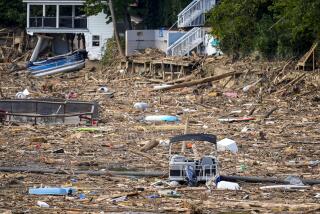Creative Class Warms to Climate Change
- Share via
If recent pop culture history is any indicator, the debate over global warming may be settled (if it gets settled at all) not so much by science as by art and mythmaking.
Discussions on climate change are at an impasse. Some of those who fret about man-made emissions of greenhouse gases claim it’s a threat that trumps all others, including terrorism. Others argue that we have more pressing concerns, such as the developing world’s dehumanizing poverty and disease. They posit that even if global warming is a problem, proposed cures, such as the Kyoto Protocol, would hamstring the global economy and be more harmful.
Into this stalemate jumps the creative class. Earlier this year, director Roland Emmerich released a big-budget movie, “The Day After Tomorrow,” that presented a future in which a globally warm world is destroyed by tsunamis and other environmental catastrophes. Now author Michael Crichton -- himself no stranger to Hollywood blockbusters (“Jurassic Park”) -- has released “State of Fear,” a thriller novel about climate change and destruction. His villains are eco-activist lawyers terrifying the public with a greenhouse boogeyman. Scared out of its wits, the public considers destructive economic austerity measures that would ruin millions of lives.
It may seem odd that the ultimate in nerdy science policy issues has morphed into a sexy canvas for sociopolitical commentary. But maybe there’s an important lesson here.
At some level, science probably will never resolve what to do about global warming. Climate change is complex, with scores of variables and time-frame considerations of decades and even centuries. Both sides have substantial data that support their points of view. Both sides also believe that to the extent the science is “settled,” it’s settled in ways that undergird their respective policy prescriptions.
But science is inherently descriptive, not prescriptive. It can only inform us about the likely consequences of actions. It doesn’t tell us -- and shouldn’t tell us -- if those actions should be taken. That arena is reserved for politics, where moral judgments and philosophical views matter alongside scientific truth. Morality and philosophy are often best examined and illustrated not through scientific discourse but through narratives, theology and storytelling.
Michael Shellenberger and Ted Nordhaus, two longtime environmental activists, seem to sense this. Recently they issued a cri de coeur to their fellow greens in a much-discussed essay called “The Death of Environmentalism.” Frustrated by what they feel is the environmental movement’s inability to push significant political action on global climate change, Shellenberger and Nordhaus suggested that “environmentalists need to tap into the creative worlds of mythmaking, even religion, not to better sell narrow and technical policy proposals but rather to better figure out who we are and who we need to be.”
Some eco-groups have taken this to heart. Just outside the convention hall of the United Nations’ ongoing climate change negotiations in Buenos Aires this week is a giant ark, reminiscent of Noah’s preparation for the flood, emblazoned with the word “Greenpeace.” Noah’s story of God’s displeasure over mankind didn’t appear in Science or the Lancet, of course, but in an ancient religious text.
Crichton, who considers environmentalism to be a kind of religion, was motivated to write his story in response to an earlier bit of eco-mythmaking, one that had real-world consequences. Rachel Carson’s 1962 book “Silent Spring” -- a kind of artistic precursor to “The Day After Tomorrow” in that it speculated about a future in which songbirds had been killed by industrial chemicals and spring was thus silent -- is one of the sacred texts of the green movement. It helped galvanize a global ban on DDT, a chemical used against malarial mosquitoes. Over time, several of Carson’s claims about DDT have been debunked, but the ban yielded millions of malarial deaths in the developing world. Crichton sees parallels to this and other environmental crusades in the concerns over global warming today.
Much of the rancor over global warming reflects a clash of conflicting moral visions of mankind and the future. As such, we can expect artistic -- as well as scientific -- debate over it to flourish.
More to Read
The biggest entertainment stories
Get our big stories about Hollywood, film, television, music, arts, culture and more right in your inbox as soon as they publish.
You may occasionally receive promotional content from the Los Angeles Times.










